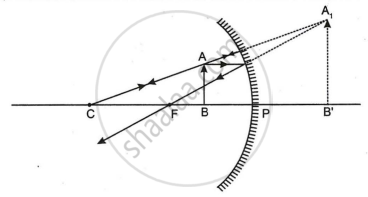Advertisements
Advertisements
प्रश्न
A student took three concave mirrors of different focal lengths and performed the experiment to see the image formation by placing an object at different distance with these mirrors as shown in the following table.
| Case No. | Object-distance | Focal length |
| I | 45 cm | 20 cm |
| II | 30 cm | 15 cm |
| III | 20 cm | 30 cm |
Now answer the following questions:
(a) List two properties of the image formed in Case I.
(b) In which one of the cases given in the table, the mirror will form real image of same size and why?
(c) Name the type of mirror used by dentists. Given reason why do they use such type of mirrors.
OR
(c) Look at the table and identify the situation (object distance and focal length) which resembles the situation in which concave mirrors are used as shaving mirrors? Draw a ray diagram to show the image formation in this case.
उत्तर
(a) In case (I), object is beyond C. For concave ‘mirrors, when the object is outside C, the image will be between C and F, and the image will be inverted and diminished (smaller than the object).
(b) In case (II), object is at C, so the image formed will be real and of same size.
(c) The dentist positions a small concave mirror so that the tooth is in focus. The dentist then examines a magnified image of the tooth in the concave mirror. Because the tooth seems considerably larger in the concave mirror, the dentist may easily check the tooth defect.
OR
(c) We are aware that a virtual and expanded picture is created when an object is positioned between P and F of a concave mirror. As a result, we can properly shave using a concave mirror because the microscopic hairs are easily visible.
In scenario (III), the object is positioned between F and P, simulating the use of concave mirrors as shaving mirrors.

APPEARS IN
संबंधित प्रश्न
To determine the approximate value of the focal length of a given concave mirror, you focus the image of a distant object formed by the mirror on a screen. The image obtained on the serene, as compared to the object is always:
(a) Laterally inverted and diminished
(b) Inverted and diminished
(c) Erect and diminished
(d) Erect and highly diminished
If an object is placed at the focus of a concave mirror, where is the image formed?
State where an object must be placed so that the image formed by a concave mirror is:
(b) at infinity.
(c) the same size as the object.
Give two uses of concave mirrors. Explain why you would choose concave mirrors for these uses.
An object is placed at a distance of 10 cm from a concave mirror of focal length 20 cm.
State two characteristics of the image formed.
A concave mirror produces three times enlarged virtual image of an object placed at 10 cm in front of it. Calculate the radius of curvature of the mirror.
The image formed by a concave mirror is of the same size as the object, if the object is placed
In the following diagram. MM' is a concave mirror and AB is an object. Draw on your answer-sheet a ray diagram to show the formation of image of this object.
Pick out the concave and convex mirrors from the following and tabulate them.
Rear-view mirror, Dentist’s mirror, Torchlight mirror, Mirrors in shopping malls, Make-up mirror.
To obtain an image twice the size of the object, between which two points related to a concave mirror should an object be placed?
